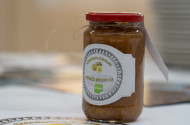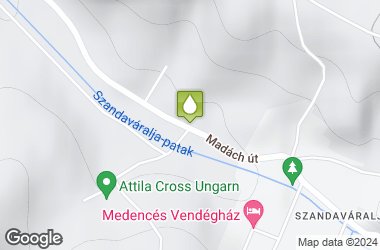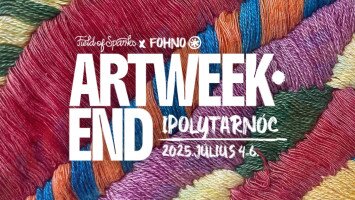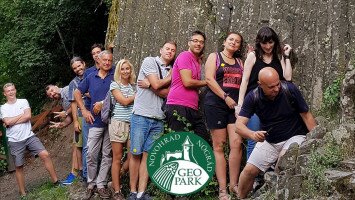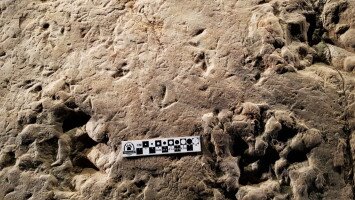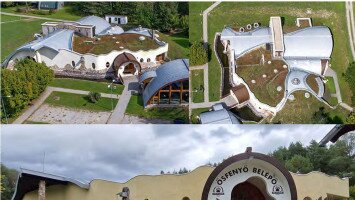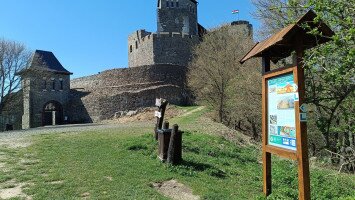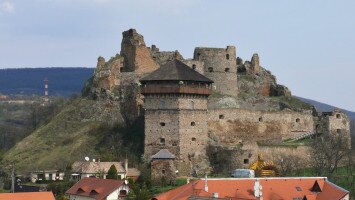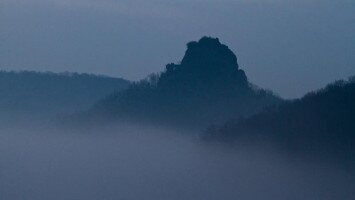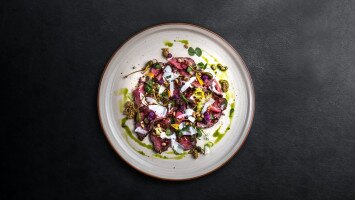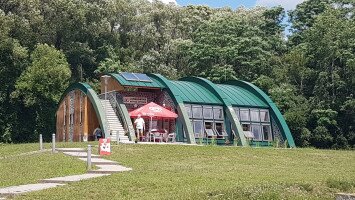
Szanda és a közigazgatásilag hozzá tartozó Szandaváralja a vulkáni eredetű Cserhát belsejében, a Szanda-hegy északi lábánál fekszik. A Szanda-hegy csúcsa (529 m) a Cserhát hegység második legmagasabb pontja. Erdővel borított és mezőkkel tarkított kiemelkedések fogják körül a völgyekbe zárt, két -egyenként is sajátos emlékekben gazdag településrészből szervesen összefonodó kisközséget.A cserháti piroxénandezitek feketés színét a bennük lévő földpátok üveg- és/vagy magnetittartalma okozza. A szandai andezit üvegében mindezen kívül tűs megjelenésű, vas-titán-oxid tartalmú ilmenitzárványok is találhatók, ez rendkívül ellenállóvá teszi a kőzetet. A vár alatt, délkeleti fekvésben rejtőzködik a talán legérdekesebb látnivaló: a három-négyemeletnyi magasságú, kb. 75 fokos dőlésű, kőbányászkodással kibontott andezitoszlop-fal. Ellentétben a közeli béri görbült oszlopokból álló andezitcsúszdával, ezek nyílegyenesek, égre törők.
Itt, a várhegy oldalában találhatóak azok a gyümölcsöskertek, amelyből a Szandaváraljai lekvárok alapanyaga származik.
A Szanda-hegy mindhárom csúcsa fontos szerepet játszott a térség történetében: valaha földvár állt a nyugatin, a középső búcsújáró hely volt, s mindkettőt bányásszák az andezitért, a keleti, 529 méter magas szirten pedig a Szandai várrom található, amelyet ma az Országos Kék Túra jelzésén lehet legegyszerűbben megközelíteni. A hegy lábánál lévő kicsi palóc települések épített örökségükben és a családi hagyományokban is őrzik őseik kultúráját - beleérve a 'palóc' gasztronómiai és kulturális hagyományokat is.
Ebben a környezetben dolgozik Viktorné Benedek Boglárka, a GEOfood védjegyes Szandaváraljai lekvárok készítője, aki a lekvárjait a szüleitől tanultak alapján készíti Szandaváralja gyümölcsöskertjeinek gyümölcseiből. A családi vállalkozás során a férje foglalkozik a mezőgazdasággal, a fák gondozásával, míg Boglárka a lekvárok elkészítésével, amelyet aztán a településre érkező turisták vásárolnak meg, hiszen a házuk közvetlenül az Országos Kék Túra nyombvonalán található.
A Szandaváraljai lekvárok alapanyaga maga is Szandaváralja gyümölcsöskertkjeiből kerül ki, amelyek a Vár-hegy oldalában húzódnak. Ezekben a gyümölcsösökben őshonos magyar gyümölcsfajtákat termesztenek, amelyek évszázadok óta jellemzőek a területre.
A területen élő palóc közösség az évszázadok során nemcsak a gyümölcstermesztés hagyományát, hanem a gyümölcsök feldolgozását is anyáról leányra hagyományozták - így míg a gyümölcs minőségét az andezites talaj, a napsütéses órák magas száma és a sajátos mikroklíma miatti sok csapaék befolyásolja, a lekvárok elkészítése a palóc gasztronómiai hagyományoknak megfelelően készül, ettől, különleges, "házi" minden lekvár.
